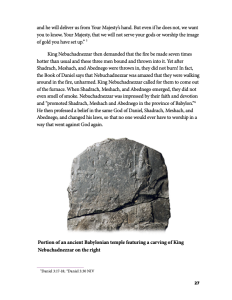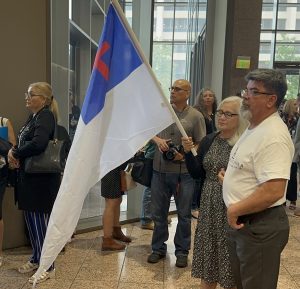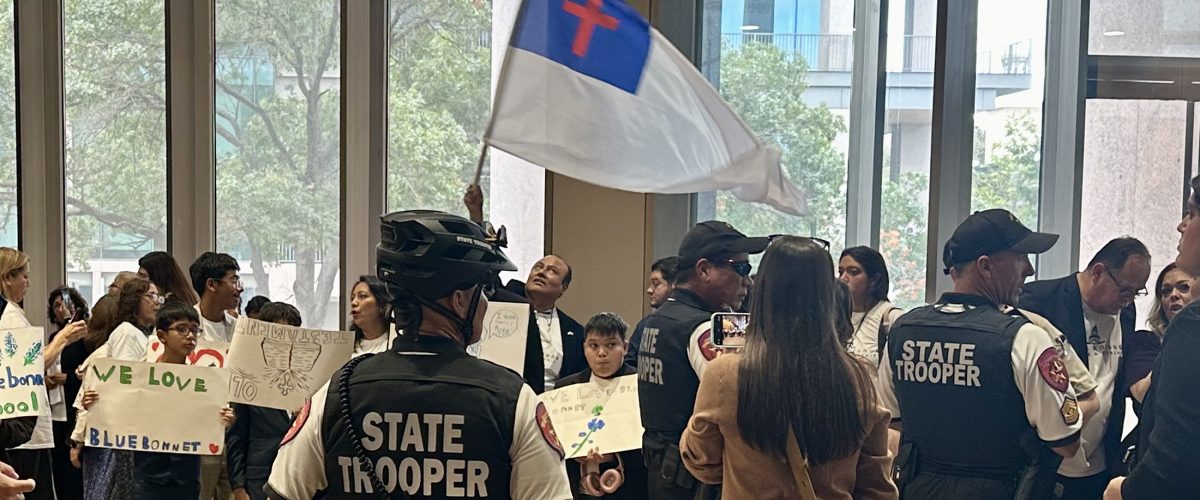Last week I spent a day in Austin, Texas, to testify for the second time against the new (and newly named) “Bluebonnet Learning K-5 Reading Language Arts” curriculum.
Despite significant opposition, the Bible-infused curriculum was approved, which should be unsurprising to anyone who has been paying attention to the politics behind the curriculum.
However, for those unfamiliar with the contents of the curriculum, here are some of the reasons lessons contained within it are really bad in so many ways.
Pedagogically unsound in teaching reading skills
Throughout the course of public testimony, both active and retired reading teachers stepped forward to criticize the curriculum’s approach to teaching reading — the primary goal of the Reading Language Arts curriculum for elementary-aged children.
In her testimony on Nov. 18, Francine Erickson — who taught reading for 15 years — demonstrated one of the lessons included in the curriculum. She followed the curriculum’s instructions, held up a picture provided to teachers and then read the text they are instructed to read aloud to children. As Erickson noted, the problem with the new Reading Language Arts curriculum is that it has cut student-centered reading time in half and instead has substituted didactic lessons on subjects the authors deem relevant for cultural knowledge and literacy.
Gone are the days of teachers sitting with students in a circle and reading aloud with big books as kids follow along. Instead, these mini-lectures delivered to young students include recitations or “read-alouds” on things like Christopher Columbus, the Pilgrims and, in one kindergarten example, how “the settlers, or people living in the settlement, tried to convince the Native Americans in the area to follow their religious beliefs. This means the settlers wanted the Native Americans to worship God as the Spanish believed.”
As Erickson noted, children who are learning to read do so by actually seeing text and practicing reading, not by listening to lectures intended to indoctrinate them to a specific view of American history.
Erickson also noted the curriculum includes only six books for the early readers to read over the course of a school year. Children who come to school already reading are forced to “throttle” their learning to stay on-pace with the other children in the class. This new curriculum eliminates individual and small-group reading time in order to keep all students at the same reading level and impart to them important cultural knowledge.
The curriculum does not challenge young readers to actually read, nor does it give them the opportunity to practice their reading skills.
My own child who entered kindergarten already reading would have been bored to tears and would have regressed in her reading skills if she hadn’t had the experience of individual and small-group reading time. That this curriculum is created for Reading Language Arts is farcical.
Obscures and rewrites history
As alluded to above, the new English Language Arts curriculum cuts reading time in half so students can be taught what the authors deem to be important cultural knowledge and literacy. This curriculum is intended to present a specific version of American history that all children are to know and believe.
In her testimony on Nov. 18, Julia Brookins of the American Historical Association — the oldest professional organization for historians in the United States — offered the association’s thoughtful critique of the “widespread weaknesses in the history lessons” presented in the curriculum:
I know the members of the board share the public’s priority that Texas schools teach students how to think, not what to think. In that light, the history in Bluebonnet Learning is a great disappointment. … U.S. history teachers actively avoid materials they consider politicized. For that reason, many thoughtful teachers who read the history lessons here might be wary about using some of them. It is disappointing that the TEA has missed an opportunity to help districts provide students and teachers with clear, well-evidenced historical content in so much of this curriculum. Unless the board can show that these are really even-handed, there may be resistance to using them in the classroom. While some of the lessons about the past are detailed and rich, others are vague and written in confusing ways that students will struggle to comprehend, much less learn history from. The best kind of history education to teach informed patriotism is simply the best history education. It requires precision and clarity. This is not it.
As I noted in my own testimony before the board, there is an obvious attempt throughout the curriculum to advance the false narrative that the United States was founded as a Christian nation. While it is absolutely true that Christianity was an influence in our nation’s founding, there were other influences, such as the Enlightenment, that played equal roles.
Further, Christianity within the colonies did not have one unified expression of the faith. Just ask the early Baptists with whom Thomas Jefferson exchanged letters about the importance of the wall between church and state.
Nevertheless, time and again the authors of the curriculum present our country’s founders as being good Christians and our country as a Christian nation. For example, the first grade unit on “American Independence” includes a read-aloud that invites students to imagine “perhaps the first full debate at this first meeting of what would eventually become the American government was about whether to pray.”
“The authors have emphasized a far less important debate to support their ideological agenda.”
It’s strange the authors ask young students to imagine prayer was the first thing those gathered discussed when we know from historical records their conversation about whether or not to open the remaining Congressional meetings with prayer didn’t happen until the second day of the gathering. It wasn’t until the third day of meetings that a prayer was offered. Yet rather than teach about The Declaration and Resolves, which was the actual signed outcome of the First Continental Congress, the authors have emphasized a far less important debate to support their ideological agenda.
On the same day last week that public testimony was taking place, the Texas Tribune ran a story quoting Brookins and detailing some of the additional problems with the way history is presented in the curriculum as it relates to slavery and racism:
“The lack of specificity is striking,’ said Julia Brookins, senior program analyst of teaching and learning for the American Historical Association with whom the Tribune shared several of the curriculum’s excerpts. A kindergarten lesson titled ‘Our Great Country,’ for example, instructs teachers to tell students that Founding Fathers like George Washington and Thomas Jefferson ‘realized that slavery was wrong and founded the country so that Americans could be free.’ The passage omits the fact that many of them enslaved people.”
In a fifth grade unit titled, “Juneteenth and Beyond,” there is a lesson on Martin Luther King’s Letter from Birmingham Jail. In the reader provided to students, the authors have sliced and diced the text so it’s hardly recognizable. In doing so, they have reshaped the message of King, diminished the racism he was fighting against, and portrayed him as being opposed to the Civil Rights protests going on.
Compare the text from the student reader with a copy of the original text:
I wonder what King would think of this bastardization of his letter.
In the student reader, after the two-page mangled version of his letter is a five-page reading about the biblical characters of Daniel and King Nebuchadnezzar from the Book of Daniel, presumably because King references them in his text. Ironically, the one sentence the authors chose to delete from the paragraph referencing Daniel and Nebuchadnezzar in the student reader is King’s note, “To a degree, academic freedom is a reality today because Socrates practiced civil disobedience.”
Christian nationalist Bible lessons imposed
The majority of the press around the curriculum has been its infusion of a certain kind of Christianity into the lessons. Here, the authors go to great lengths to wedge mentions of Jesus and a Neo-Calvinist Protestant Christianity into the curriculum. It’s literally everywhere.
 For example, in the fifth grade activity book to go along with the reading of C.S. Lewis’ The Lion the Witch and the Wardrobe (an allegory about the self-sacrifice and resurrection of Jesus Christ), the end-of-year grammar assessment includes a section where students are to write the correct (meaning normative cisgender) pronouns given the context clues. One question has students write the correct gender pronoun next to Martin Luther (as in, the leader of the Protestant Reformation). On the next page students are to fill in the correct pronoun antecedent for the sentence “Martin Luther nailed ____ Ninety-Five Theses to the church door at the University of Wittenberg.” Yet, this is the only mention of Martin Luther in all the curriculum. The Protestant reformer’s name seems to be thrown into a grammar assessment solely so fifth graders ask who he was.
For example, in the fifth grade activity book to go along with the reading of C.S. Lewis’ The Lion the Witch and the Wardrobe (an allegory about the self-sacrifice and resurrection of Jesus Christ), the end-of-year grammar assessment includes a section where students are to write the correct (meaning normative cisgender) pronouns given the context clues. One question has students write the correct gender pronoun next to Martin Luther (as in, the leader of the Protestant Reformation). On the next page students are to fill in the correct pronoun antecedent for the sentence “Martin Luther nailed ____ Ninety-Five Theses to the church door at the University of Wittenberg.” Yet, this is the only mention of Martin Luther in all the curriculum. The Protestant reformer’s name seems to be thrown into a grammar assessment solely so fifth graders ask who he was.
While the curriculum is filled with these odd, one-off Christian references, elsewhere Christian theological claims are presented as ethical guidelines everyone should follow.
For example, kindergartners are introduced to the distinctly Christian theological language of “serving our neighbor” in a lesson on “the Golden Rule” as told by Jesus, “a man who lived a long, long time ago — nearly 2,000 years ago — in a part of the world that is very far from here.”
In this lesson on Jesus’ Sermon on the Mount, the authors have taken a rich theological text on which entire books have been written and have presented it as a trite aphorism with the sole purpose being to introduce our youngest students to Jesus.
Another lesson in the same unit tells the story of “the Good Samaritan” in an equally two-dimensional way. It’s almost as if the curriculum’s authors didn’t know the story titles and headings in our English Bibles are added by the translators and aren’t actually in the original Greek text.
These lessons read like Sunday school curriculum and have no place in a state-owned, state-sponsored, public school curriculum.
But these Christian theological lessons pale in comparison to other lessons in which the Bible is presented as both history and science textbooks.
“These Christian theological lessons pale in comparison to other lessons in which the Bible is presented as both history and science textbooks.”
In a unit called “Exploring Art: The Beauty We See,” kindergarten students are introduced to the first creation narrative in Genesis in which God creates the cosmos and world in six days and rests on the seventh. Given that kindergartners are unable to discern make-believe from reality, an authority like a teacher introducing this account of creation as fact is deeply problematic. The authors attempt to hide their anti-evolution creationist worldview by presenting this biblical account in a lesson on art:
Genesis is the first book in the Torah, the first part of the Hebrew and Christian Bibles. The book of Genesis includes a description of the creation of the world. Creation means the act of making or producing something that is new. Creation stories help people understand their place in the world. Many artists have found inspiration for creating art from the words in creation stories in religious books. Inspiration means they get ideas. They want to retell the stories they read with vivid, or bright, colors and lines. Let’s find out how Roelandt Savery used the creation story from the book of Genesis as inspiration for his painting. To do this, we will read from the story that inspired him.
 The lesson goes on to instruct the teacher to quote Scripture (“And God said, ‘Let there be light,’ and there was light”) while showing images of Savery’s artwork.
The lesson goes on to instruct the teacher to quote Scripture (“And God said, ‘Let there be light,’ and there was light”) while showing images of Savery’s artwork.
Elsewhere in the curriculum, characters from the Bible are presented as historically accurate alongside other “secular” characters, thus blurring the function of sacred Scripture.
One example from the kindergarten unit on “Kings and Queens” has a lesson on the biblical story of King Solomon. The story is used to demonstrate that nonfiction kings have lived throughout history. However, the other nonfiction king presented in the unit is the Muslim king Mansa Musa — a character not taken from sacred texts. The authors easily could have chosen another king from history — even a Jewish or Christian king — taken from sources other than the Bible. But doing so would have undermined their intention of showing the Bible to be a factual accounting of history.
The Bible is neither history nor science book. To present it as such introduces the neo-Calvinist belief in the Bible as inerrant and infallible — a belief that coincides with Christian nationalism and Christian nationalist identity.
It never was about reading language arts
The Christian nationalist politicians behind this curriculum have been saying aloud their intentions from the beginning. This curriculum is not about teaching children to read or about a historically accurate account of our country and world. It is and always has been about indoctrinating students into a Christian nationalist worldview — one that holds the United States was founded as a neo-Calvinist Christian nation and, given what adherents see as the country’s moral decline, should be transformed into a full-blown theocracy.
This belief about the curriculum was on full display at last week’s hearing for public comments. In the lobby of the state-owned Board of Education building, those of us testifying were greeted by a Christian nationalist, charismatic revival complete with shofar-blowing and Christian flag-waving “prophets” and their followers — including children holding signs.
 And, if that weren’t shocking enough, some of the board members were greeting and physically embracing the Christian nationalists in the lobby.
And, if that weren’t shocking enough, some of the board members were greeting and physically embracing the Christian nationalists in the lobby.
Several from the charismatic group testified in support of the curriculum. They, along with others the Christian nationalist organization Texas Values had recruited, spoke about the importance of teaching Christian values to all American children because those values represent God’s truth for the nation.
Undoubtedly, the new curriculum will face legal challenges in the coming weeks and months as Texas’ local independent school districts vote on whether or not to use the state-owned curriculum. The state of Texas has incentivized the adoption of its curriculum by offering districts $60 per student to use it.
It is truly hard to imagine a more vivid example of what our country’s founders were protecting us from when they wrote the First Amendment to the Constitution declaring: “Congress shall make no law respecting an establishment of religion.”
With Texas’ new curriculum, the Christian nationalists have set themselves up for a test case to determine whether the courts will allow them to destroy one of our country’s founding principles.
Mara Richards Bim serves as a Clemons Fellow with BNG and as program director at Faith Commons. She is a spiritual director and a recent master of divinity degree graduate from Perkins School of Theology at SMU. She also is an award-winning theater artist and founder of the nationally acclaimed Cry Havoc Theater Company which operated in Dallas from 2014 to 2023.
Related articles:
The shocking things I witnessed at the Texas Board of Education | Analysis by Mara Richards Bim
Texas Board of Education gets huge pushback on religion-infused curriculum
Proposed new Texas school curriculum infused with Bible stories







